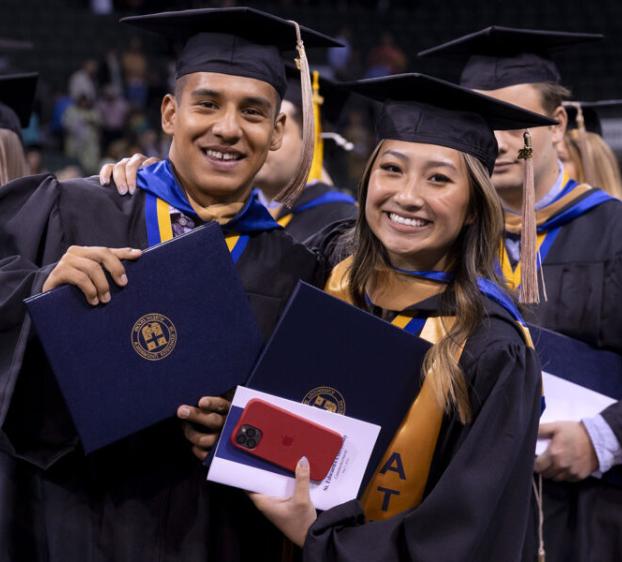Explore How Biology Impacts Our Habits With a Degree in Behavioral Neuroscience
Behavioral Neuroscience explores topics in mental health, cognitive functions, sleep, social behavior and much more.
Students who pursue this major have varying interests in professional or research careers in medicine, pharmaceuticals, animal science and neuroscience.
Why earn your Behavioral Neurosicence degree at St. Edward's?
Whether you want to pursue a career helping people coping with mental-health concerns or addiction, in a hospital or physical therapy clinic setting, one thing is certain: The advantages of your St. Edward’s education will prepare you to succeed. You’ll find opportunities in and outside the classroom to learn, give back and achieve your goals. And your mentors will support you every step of the way.
Beneficial for students on a pre-health path
Pre-health students find this major an ideal fit, because the degree requirements align with medical or graduate school requirements.
Gain knowledge as a teaching assistant
You’ll have the chance to serve as a teaching assistant and lead study sessions. You’ll enhance your leadership, communication and people skills — all while helping fellow students learn the material.
Conduct graduate-level research
The Behavioral Neuroscience program helps you develop top-notch research skills. You’ll learn how to design and conduct your own study, analyze your data, and write a manuscript explaining the results.
Build relationships with your professors
You’ll learn in small classes taught by award-winning professors who make a point of getting to know you and becoming your trusted advisors. They’ll help you identify and focus on your goals, and provide guidance and insight during and after your college years.

Reap the Rewards of Austin
As an upperclassman, you’ll take the Research and Field Experience course, which requires the completion of an internship at a community organization, lab or clinical facility. Austin is home to many treatment facilities, hospitals and clinics suitable for students who need to gain educational internship experiences.
What do our graduates do?
Behavioral Neuroscience majors go on to a variety of careers and graduate schools from St. Edward’s. Here are examples from recent graduates.
- Business development executive for startups
- Behavioral data coordinator at MediaScience
- Neuropsychiatry research coordinator at Baylor College of Medicine
- Outreach program and data coordinator for Girls Inc.
- School psychologist in Austin Independent School District
- Graduate school placement in doctorate programs in neuroscience at Colorado State University, University of Texas, Scripps Institute, and Icahn School of Medicine
- Clinical Psychology doctorate program at Palo Alto University
- Medical school placement at various schools across the country
Explore Details About a Degree in Behavioral Neuroscience
Major Requirements: The BS in Behavioral Neuroscience requires 60 hours of major-specific courses, which include a combination of psychology and natural sciences coursework.
Electives: Students complete 39 hours of elective courses in any area of study they choose. These courses do not have to relate to the major.
General Education Requirements: The degree requires 748 hours of general education courses that students complete over four years, in addition to their major courses and electives.
View and download the full degree plan for the Behavioral Neuroscience major (PDF).
A few examples of courses students in this major take:
- Biopsychology – Delves into the function and anatomy of the nervous system and the role it plays in directing thought and behavior.
- Behavioral Neuroscience – Students will examine how the central nervous system mediates perceptions, emotions, memories, and other behaviors.
- Learning and Cognition - Students study how our experiences change the brain’s structure and how the brain works. The course examines learning principles, memory processes, language, and cognitive skills.
Skills You Will Gain
Behavioral Neuroscience majors are outstanding scientists with excellent research skills. You’ll develop those skills in classes that include labs, so you can apply what you’ve learned, and in internships and research you conduct with professors.
Research
Classes like Research Methods equip you with skills learned through hands-on experience. You’ll have the opportunity to assist faculty with their research projects and pursue your own area of inquiry. Behavioral Neuroscience majors have examined the following topics:
- The impact of recreational drug and alcohol use on stress response
- The impact of the COVID-19 pandemic on coping behaviors, relationships, and social media dependency
- The influence of race and gender on pain empathy
- How sex education shapes people’s attitudes about gender, bodily autonomy and sex
- How different types of trauma exposure are associated with the stress hormone cortisol
Students present their research at professional academic conferences like the Southwestern Psychological Association, the Society for Neuroscience and the Society for Behavioral Neuroendocrinology. They win national awards and are accepted into top graduate programs in the country.
Students are encouraged to gain internship experience at any point during their college career. Behavioral Neuroscience majors have recently completed internships at the following sites:
- MD Anderson Cancer Research Center
- The Twin Project at the University of Texas
- Pricilla Pond Flawn Child and Family Lab
- BlueSprig, which specializes in Applied Behavior Analysis therapy for children with autism
- Anxiety Treatment Center of Austin
- National Alliance on Mental Illness
- Center for Autism and Related Disorders
- Trinity Child Development Center
At St. Edward’s, our faculty are outstanding scholars, thought leaders, teachers and mentors who bring energy and enthusiasm to our vibrant learning community. They take pride in getting to know you, helping you achieve your goals and celebrating your successes.
View a list of our faculty members and their contact information on the Department of Psychology and Behavioral Neuroscience webpage.

Earn Two Degrees in Five Years
With our Accelerated Graduate Pathways, you can complete your BS in Behavioral Neuroscience and one of two master’s degrees in as little as five years, saving time and money. See details and requirements.
- Behavioral Neuroscience to MEd in Applied Behavior Analysis
- Behavioral Neuroscience to MS in Business Analytics
Success coaches and academic advisors guide you through undergraduate and graduate courses to maximize benefits.
